Toggl Track remains one of the most recognizable time trackers thanks to its minimalist interface and quick setup. Yet, in 2025 many teams need more: deeper analytics, workload visibility, transparent client reports, or even automatic time capture. If you feel Toggl Track no longer meets your growing business demands, this guide is for you. We examined ten notable alternatives, highlighted their strengths and weaknesses, and created a comparison table. Center stage goes to Worksection — a solution that merges a time tracker with full project management and never charges extra for core tools.
Why do users look for Toggl Track alternatives?
Despite its popularity, Toggl Track receives recurring criticism. First, the free tier lacks advanced reports: to export deep analytics you must move to a paid plan, which can strain a budget. Second, its control mechanisms are limited — no screenshots, GPS stamps, or precise task-level breakdown — only a general timer. Managers overseeing distributed teams often need more detail. Third comes integration: while basic connectors exist, automatic sync with Kanban boards, for example, is missing. Permissions are another pain point: you cannot show a client just part of a project without manual cleanup. Finally, demand is rising for automated time capture that records active windows and websites in detail; Toggl Track handles this only partially. Combined, these gaps push users toward more flexible tools with stronger analytics and easier time accounting.
Selection criteria for a 2025 time tracker
The main benchmark is the balance of functionality and price. Clients want key capabilities — reports, auto- and manual tracking, visualization, collaboration, and security — to be included in the base fee, not sold as add-ons. Flexibility comes next: a modern tracker should support both classic timers and automatic modes, collect app and web data, and build dashboards. Integrations with task managers and CRMs are essential; the fewer manual transfers, the higher productivity. Security matters: end-to-end encryption, role-based access, and two-factor authentication are now expected. Remote work also elevated transparency: one-click report sharing without exporting to Excel. Last, ease of use and onboarding weigh heavily; complex enterprise tools often lose points on UX alone.
Best Toggl Track alternatives in 2025
Below are ten services that frequently appear on shortlists when teams migrate from Toggl Track. First, a quick synopsis, followed by an in-depth look at each platform.
Worksection
Worksection is more than a time tracker; it is a complete project-management suite available from the very first plan.
- Sophisticated task structure. Teams can work in list view, on a Kanban board, or inside a full Gantt chart — no tool-hopping required.
- Task-level time tracking. Employees start a timer or log hours manually, while managers see consolidated project summaries.
- Reports without extra fees. Detailed summaries of time, budgets, and workload are generated in two clicks and support custom branding.
- Granular access control. Clients, contractors, and external experts can be invited and restricted by project or section, safeguarding internal data.
- Transparent pricing. Every feature — from Gantt to API — sits inside the Start plan. A 20-person team pays about $49 per month; the Business plan ($99) removes user limits and adds advanced roles.
- Fast onboarding. The interface is localized in English, Russian, and Ukrainian, and most new teams master the basics within an hour.
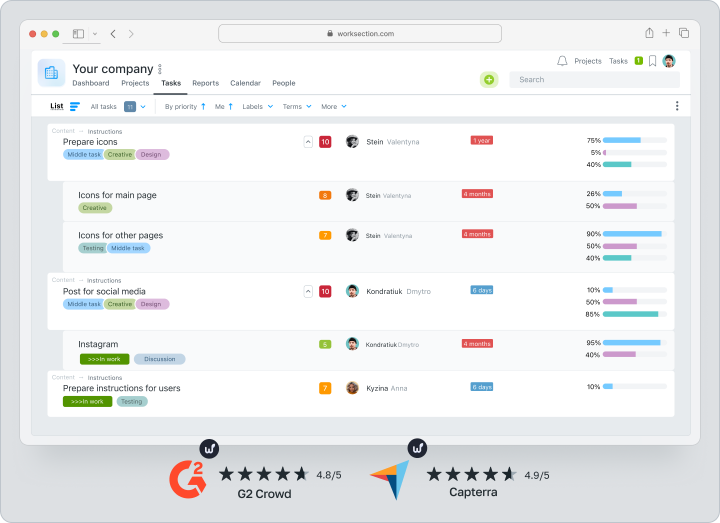
For agencies, startups, and product teams that need both time tracking and project management in one window, Worksection often tops the shortlist.
Clockify
Clockify retains its status as one of the best free time trackers: unlimited users, unlimited projects, and basic dashboards are available immediately after sign-up. Add browser extensions, mobile apps, and Zapier integrations, and you have a flexible tool for freelancers and mid-sized teams alike. Paid options (from $3.99 per user per month) unlock site-visit monitoring and deeper analytics. If you need a Gantt chart or Kanban board, however, you must sync Clockify with an external project manager, increasing the risk of forgotten time entries.
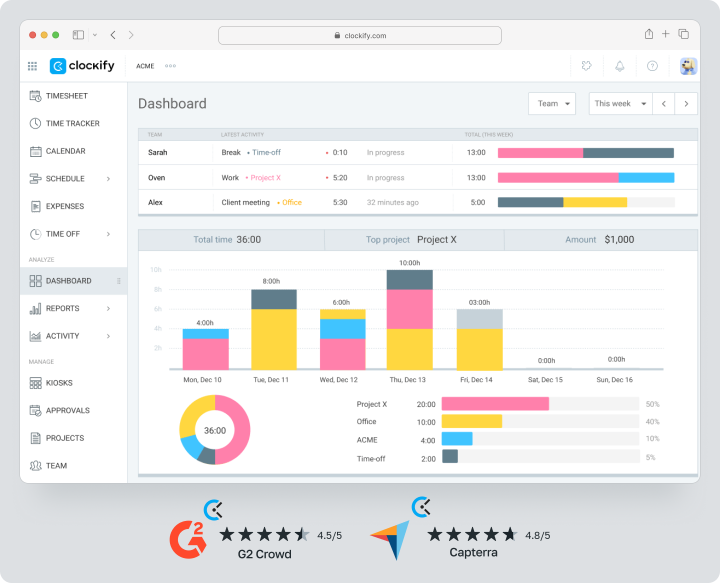
TMetric
TMetric focuses on developers, agencies, and studios that link time tracking directly to billing. The workflow is simple: pick a project, press “Start,” and the timer runs. A built-in cost module multiplies hours by employee rates to show revenue. Budgets, workload diagrams, and an API come standard. The Basic plan (about $5 per user) includes key reports; Enterprise adds SSO and task templates. Missing pieces: screenshots and automatic app tracking.
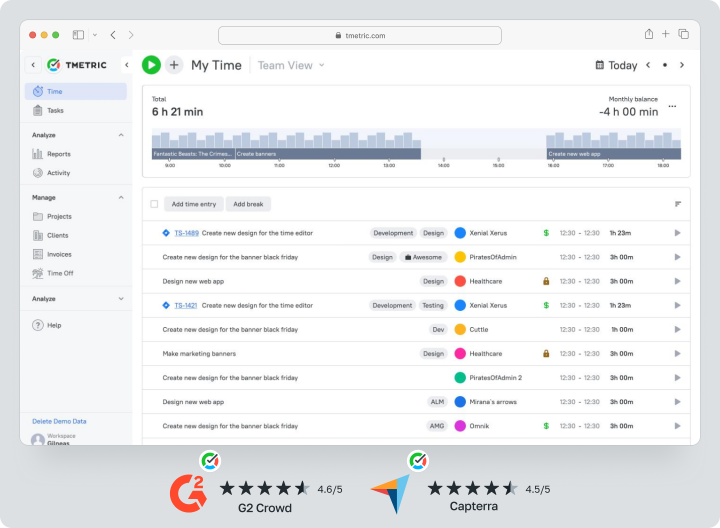
Harvest
Harvest combines time tracking and invoicing, making it popular among consultants and creative studios. Connect PayPal or Stripe, generate an invoice from logged hours, and send it from within the app. Expense tracking — software, travel, and so on — helps finalize statements. Pricing is $12 per user per month, yet the free plan limits you to two projects. Reports and budget visualization are convenient, but Harvest offers almost no task management; you must rely on an external PM tool.
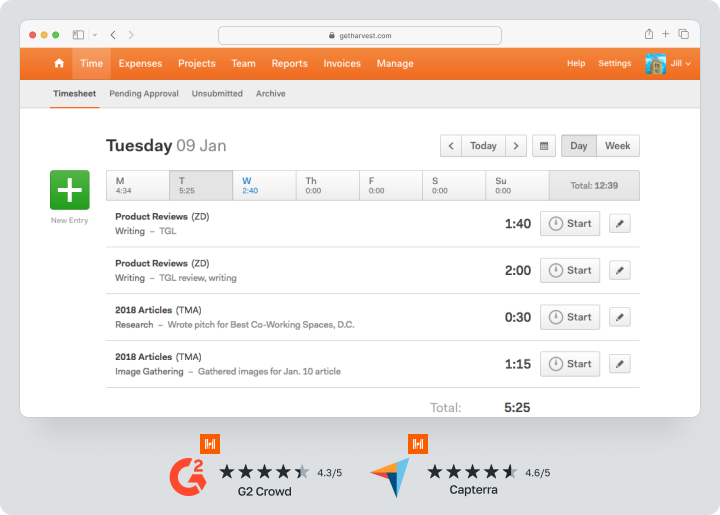
Time Doctor
Time Doctor suits companies needing a fine-grained view of the workday: it captures screenshots, records active windows, and even tracks idle mouse and keyboard time. Managers receive productivity scores; employees get pop-ups if they step away too long. In 2025 the system added blurring of sensitive data on screenshots, easing GDPR compliance. Price starts at $7.99 per user. Strengths are control and analytics; drawbacks include ethical concerns over surveillance and zero Kanban functionality.
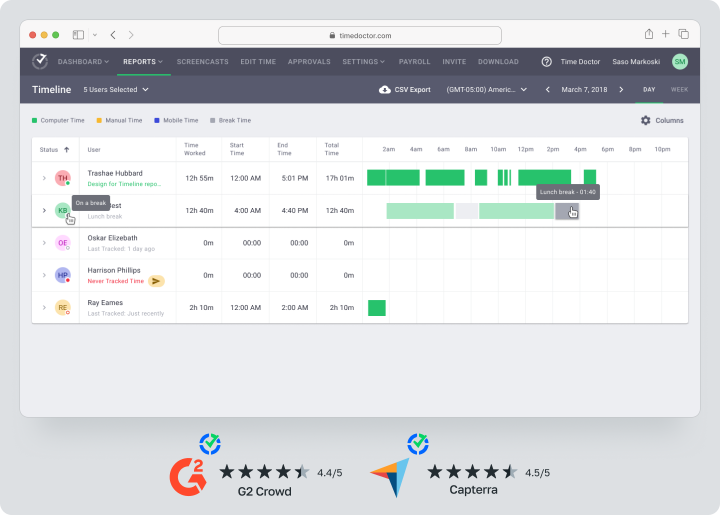
Timely
Timely bets on automatic tracking: a local app quietly records which programs and files you use, then suggests allocating those blocks to projects. Forgetting to start a timer becomes impossible. The AI module in 2025 improved its detection of activity types (code, design, meetings) and recommends categories. Plans begin at $11 per user. Reports target individuals; compiling team-wide analytics still requires manual work.
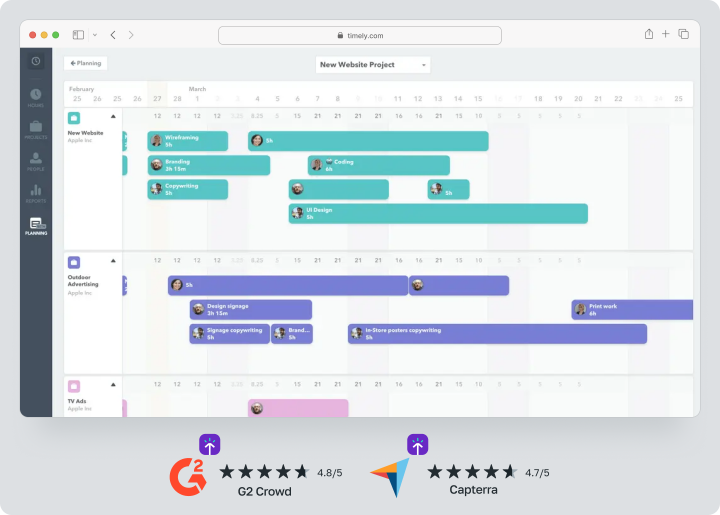
Hubstaff
Hubstaff blends time tracking, GPS routes, and light task management. Employees on the road are logged at client locations, with real travel time displayed. Screenshots, reports, and automatic payroll calculations round out the feature set. The Start plan (up to $4.99) limits functionality, so most teams adopt Premium at $7.50 per user. Drawback: a crowded interface can slow down new users.
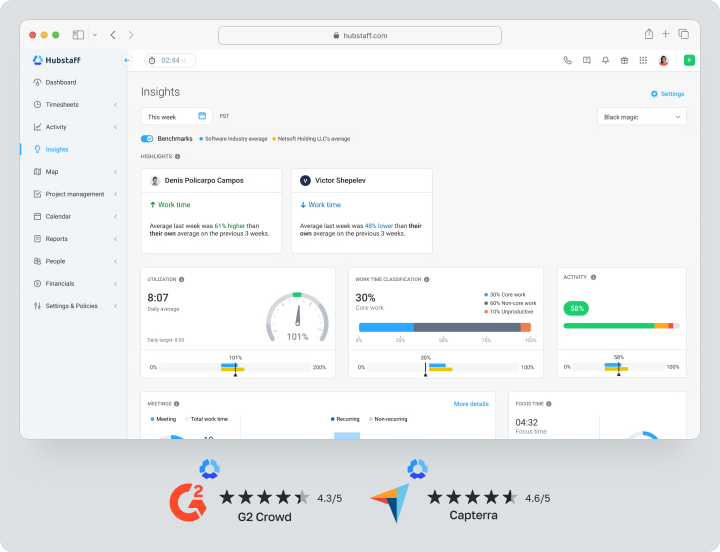
Everhour
Everhour is famous for deep integrations: Asana, Trello, ClickUp, and even Notion gain native timers inside each task card. You see cumulative hours on a Kanban column and instantly compare them with the budget. Surfacing time data inside your familiar project manager saves countless clicks. Pricing is $10 per user, though the minimum package starts at five seats. Everhour lacks its own task module, functioning as an “overlay” atop your existing project system.
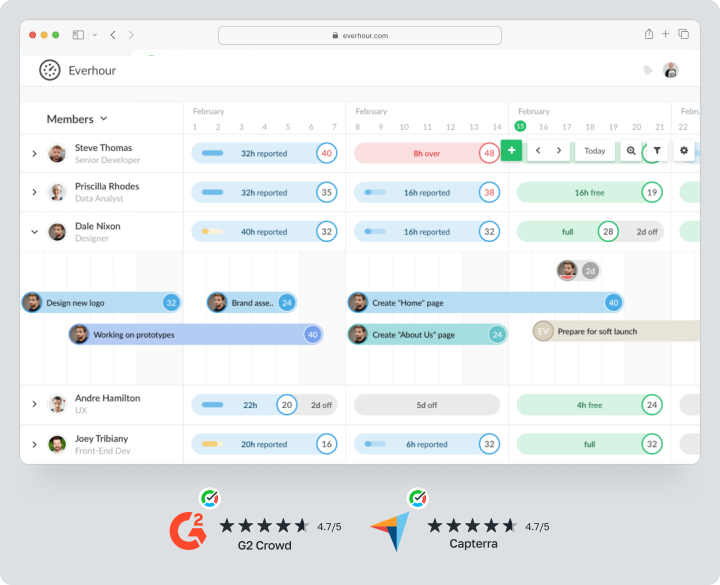
RescueTime
RescueTime zeroes in on personal productivity: algorithms classify websites and apps, assign productivity scores, and chart focus hours. The interface became more social: you can share achievements with colleagues. The “Focus Session” feature blocks distracting sites for a preset interval. Great for individual contributors, RescueTime offers no manager-level control because reports remain private. The Starter tier is free, and Premium costs $12 monthly.
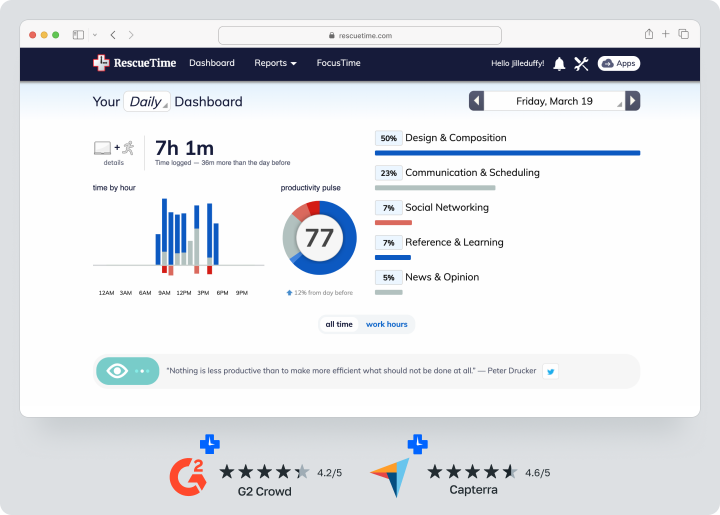
DeskTime
DeskTime is an automatic tracker that launches with the OS and logs all active app time. Work is shown in a calendar view; idle periods are clearly marked. A shifts module helps schedule holidays and absences. The Basic tier costs $7 per user. In 2025 DeskTime added Slack status badges so managers see who’s active in real time. Downside: reports are plentiful, yet customizing them is harder than in Worksection or Clockify.

Comparison table of the best Toggl Track alternatives
| Service | Timer / Auto-Track | Reporting & Visualization | Task Management | Control (Screens / GPS) | Client Access | Base Price (user / month) |
| Worksection | Timer + manual | Charts, budgets | Kanban, Gantt, list | No screenshots | Flexible roles | ≈$2.45 |
| Clockify | Timer, auto-AFK | Basic dashboards | None | None | Limited | Free |
| TMetric | Timer | Financial reports | None | None | Yes | $5 |
| Harvest | Timer | Finance, budgets | None | None | Built-in invoicing | $12 |
| Time Doctor | Timer + auto | Productivity graphs | None | Screenshots, webcam | Limited | $7.99 |
| Timely | Full auto-track | AI analytics | None | None | None | $11 |
| Hubstaff | Timer + auto | Detailed reports | Basic | Screenshots, GPS | Limited | $7.50 |
| Everhour | Timer | Inside PM platforms | None | None | Via PM tool | $10 (min 5) |
| RescueTime | Full auto-track | Personal analytics | None | None | None | $12 |
| DeskTime | Full auto-track | Calendar, charts | None | Screenshots (opt.) | Limited | $7 |
Which platform should you pick in 2025?
If you manage a team and want tasks, deadlines, and time tracking in one interface, consider Worksection. The service covers all core scenarios without bolt-on modules: the timer lives inside every task, reports build automatically, and clients see only their projects. Developing software or creative concepts? TMetric or Harvest will link hours to budgets and let you send invoices quickly. Need exhaustive transparency for remote staff? Time Doctor or Hubstaff supply screenshots and GPS, though you must address privacy concerns. Solo professionals focused on personal insights should look to RescueTime or Timely — minimal setup, maximum takeaways. On a zero budget but need unlimited users? Clockify remains the number-one pick.Frequently Asked Questions (FAQ)
Which Toggl Track alternative suits businesses best?
Businesses need reports, roles, and integrations. Worksection leads thanks to full project management and granular permissions; Hubstaff excels with GPS and field-service tracking; TMetric shines for budget-linked billing.
Are there free Toggl Track equivalents?
Yes. Clockify offers unlimited users at no cost. Worksection’s entry tier is also free if you require only basic features for a small team. RescueTime provides a free Starter plan for personal use.
How is Worksection different from Toggl Track?
Toggl Track is primarily a time tracker. Worksection merges time tracking with Kanban boards, a Gantt chart, and a calendar. Thus, you manage projects end-to-end without switching apps. Clients see only what you allow, and managers receive consolidated analytics without extra charges.
Bottom line: The right tracker depends on your business needs. For an all-in-one solution with transparent pricing, Worksection is arguably the most promising Toggl Track replacement in 2025.